The Thai government expects to welcome over 40 million tourists in 2024. Thailand, along with other Southeast Asian countries, remains a top destination for travellers. Its unique charm, stunning scenery, and diverse culture keep attracting more people eager to explore what the region has to offer.
In today’s article, we’ll take a look at the quality and speed of mobile Internet across countries such as Thailand, the Philippines, Malaysia, Indonesia, Vietnam, and Singapore.
Mobile Internet in Southeast Asia – availability, quality and speed
Mobile Internet has grown significantly across Southeast Asia recently, becoming essential for accessing digital information and services. This region includes countries like Indonesia, Malaysia, Thailand, the Philippines, and Vietnam, all of which are seeing a rapid increase in mobile Internet users. These countries have a notably young population that is quickly embracing new technologies. For example, in Indonesia, the most populous country in the region, more than half of the population is under the age of 30, which helps to drive the fast adoption of mobile technologies.
Mobile Internet availability can vary significantly. In cities and major economic centres, you’ll typically find strong and stable signals, but rural areas often struggle with weaker telecommunications infrastructure. Additionally, challenging terrain like the mountainous regions of Vietnam or the sprawling islands of Indonesia and the Philippines makes network expansion difficult. To overcome these issues, governments and private companies in many of these countries are investing heavily in expanding 4G networks and rolling out 5G technology to improve access to high-speed mobile Internet.
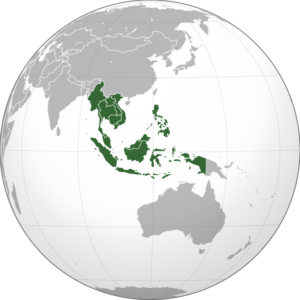
Tourists heading to Southeast Asia should keep a few things in mind when using mobile Internet. First, it’s a good idea to check out the local SIM cards available and find out which ones offer the best data packages and coverage. In many countries in the region, such as Thailand, Malaysia, and Vietnam, buying a SIM card at the airport or in the city is easy and affordable. Operators provide a range of plans designed to suit tourists’ needs.
Another key factor to consider is the quality and speed of the Internet connection. In major cities and tourist hotspots like Bangkok, Bali, or Kuala Lumpur, you can expect good coverage and fast Internet. However, in more remote areas and on smaller islands, the signal might be weaker or less stable.
Travellers to Asia should also be cautious when using public Wi-Fi networks. Free Wi-Fi is commonly available in cafes, hotels, and restaurants, but these networks might not be secure. Using a VPN (Virtual Private Network) can help safeguard your privacy and personal information when connecting to public hotspots.
What is the speed of mobile Internet in the Philippines?
The Philippines has 3 major mobile operators: Smart Communications, Globe Telecom, and Dito Telecommunity, with Smart and Globe each serving over 50 million subscribers. There are also several other active mobile service providers, including mobile virtual network operators (MVNOs), offering a variety of plans.
Cherry Prepaid operates on Globe Telecom’s infrastructure and provides simple prepaid plans and mobile devices. Sun Cellular and TNT, subsidiaries of Smart and Globe respectively, offer both prepaid and subscription plans aimed at customers seeking affordable options. TM, another brand under Globe Telecom, focuses on prepaid services. Additionally, Malaysian MVNO Redone Mobile, currently operating in Thailand, plans to expand into the Philippines.
Mobile Internet speeds in the Philippines are generally satisfactory but somewhat slower compared to other countries in the region. The average download speed is around 30.77 Mbps, with an upload speed of 8.1 Mbps. Notably, the ping rate is about 25 ms, ensuring relatively smooth and stable connections, crucial for both everyday tasks and more demanding applications.
What is the speed of mobile Internet in Indonesia?
Indonesia, the fourth most populous country in the world, has a highly competitive telecommunications sector catering to its diverse population. The largest operator is Telkomsel, a subsidiary of Telkom Indonesia and Singtel. Other major players include Indosat Ooredoo, part of Qatar’s Ooredoo Group, and XL Axiata from Malaysia’s Axiata Group. Additionally, Tri Indonesia (3), part of the Hutchison Asia Telecom Group, and the privately-owned Smartfren, which specialises in 4G and 5G services, also make significant contributions to the market. These companies offer a wide range of services across Indonesia, giving consumers plenty of choices.
The RFBENCHMARK study shows that Indonesia’s mobile Internet speeds are slower compared to its regional neighbours. The average download speed stands at 29.3 Mbps, and the ping reaches 26 ms. However, the upload speeds are relatively strong at 14.6 Mbps. Although these figures don’t quite match up to other countries in the region, users can still enjoy a satisfactory mobile Internet experience.
What is the speed of mobile Internet in Malaysia?
In Malaysia, the mobile Internet market is well-developed, featuring 5 major mobile operators and 9 mobile virtual network operators (MVNOs). CelcomDigi leads the pack with 20.3 million subscribers, followed by Maxis/Hotlink, which has over 11.67 million users. Other notable providers include U Mobile, Unifi, and Yes, all of which have established significant customer bases over the years.
All of the major operators, including CelcomDigi, Maxis, U Mobile, Unifi, and Yes, have continually upgraded their networks. They’ve transitioned from 2G to now support 3G, 4G, and in some cases, 5G technologies to accommodate the increasing demand from customers.
SIM cards are widely available across the country, although in rural areas, choices might be limited to 1 or 2 providers. To avoid any hassle, it’s best to buy a SIM card at airports or in tourist-friendly areas of cities.
The quality and speed of mobile Internet in Malaysia are exceptionally high, making it a leader in the Southeast Asian region. The country boasts average download speeds of 93.65 Mbps, upload speeds of 22.25 Mbps, and a ping of 25 ms.
What is the speed of mobile Internet in Singapore?
Singapore is recognised globally as one of the most technologically advanced countries, a status reflected in both the availability and quality of its mobile Internet. There are 2 main types of mobile operators in Singapore: mobile network operators (MNOs) and mobile virtual network operators (MVNOs).
MNOs such as Singtel, StarHub, and M1 operate their own infrastructure, including telecom towers and base stations, which enable them to provide a range of mobile services like voice, data, and messaging. These 3 companies are known for their excellent coverage across Singapore.
On the other hand, MVNOs don’t own network infrastructure. Instead, they lease network capacity from the MNOs and often offer more specialised services, such as low-cost plans or plans tailored to specific customer groups.
Thanks to this advanced infrastructure and cutting-edge technology, Singaporeans enjoy very fast and reliable mobile Internet. The average download speed is an impressive 100.5 Mbps, with upload speeds at 18.19 Mbps. Additionally, Singapore benefits from low ping values, averaging around 18 ms, ensuring smooth online experiences.
What is the speed of mobile Internet in Thailand?
At the end of 2023, Thailand had 3 major mobile operators: AIS, DTAC, and TrueMove. The mobile market in Thailand is highly developed, with about 98 million subscribers. With a population of approximately 66 million, this translates to a penetration rate of 148%.
AIS is the largest operator in Thailand, with over 40 million subscribers. It offers a range of services, including 3G and 4G networks as well as mobile Internet and data services. AIS holds about 45.51% of the market share.
After DTAC and TrueMoveH (TRUE) merged, they formed Thailand’s second-largest mobile operator, capturing about 52.92% of the market in 2023. DTAC is known as one of the leading providers of data packages for tourists.
Before the merger, TrueMove was the third largest mobile operator in Thailand, but post-merger, it became one of the most important players in the market.
Alongside these major operators, Thailand has several mobile virtual network operators (MVNOs) that utilise the infrastructure of the main operators. Well-known MVNOs include National Telecom, Feels, Red One, Penguin SIM, and I-KOOL 3G.
Compared to other countries in the region, Thailand offers fairly good mobile Internet speeds, although it ranks in the middle tier. The average download speed is 49.25 Mbps, the upload speed is 14.5 Mbps, and the ping is around 24 ms, which is typical for the Indochina region.
What is the speed of mobile Internet in Vietnam?
Vietnam’s mobile operator market is dominated by several key players, each offering a range of telecommunications and Internet services. Viettel Telecom leads the pack with its extensive coverage and innovative 4G and 5G services. Vinaphone, the second-largest state-owned operator, is known for its reliable mobile services. Mobiphone, another state-owned entity, is popular for its appealing tariff plans and promotions. On the private side, Vietnamobile targets urban markets with competitive pricing and diverse tariff plans, attracting a younger audience. Gmobile, though smaller, focuses on providing affordable services to customers in smaller towns and rural areas.
In terms of performance, Vietnam offers an average download speed of 45.18 Mbps, which supports efficient Internet browsing and smooth video streaming. The average upload speed is impressive too, at 21.3 Mbps—one of the best in the region, allowing for quick file transfers. Additionally, a ping of 23 ms ensures low latency, which is important for real-time application users.
Maps mobile internet quality and speed in Southeast Asia
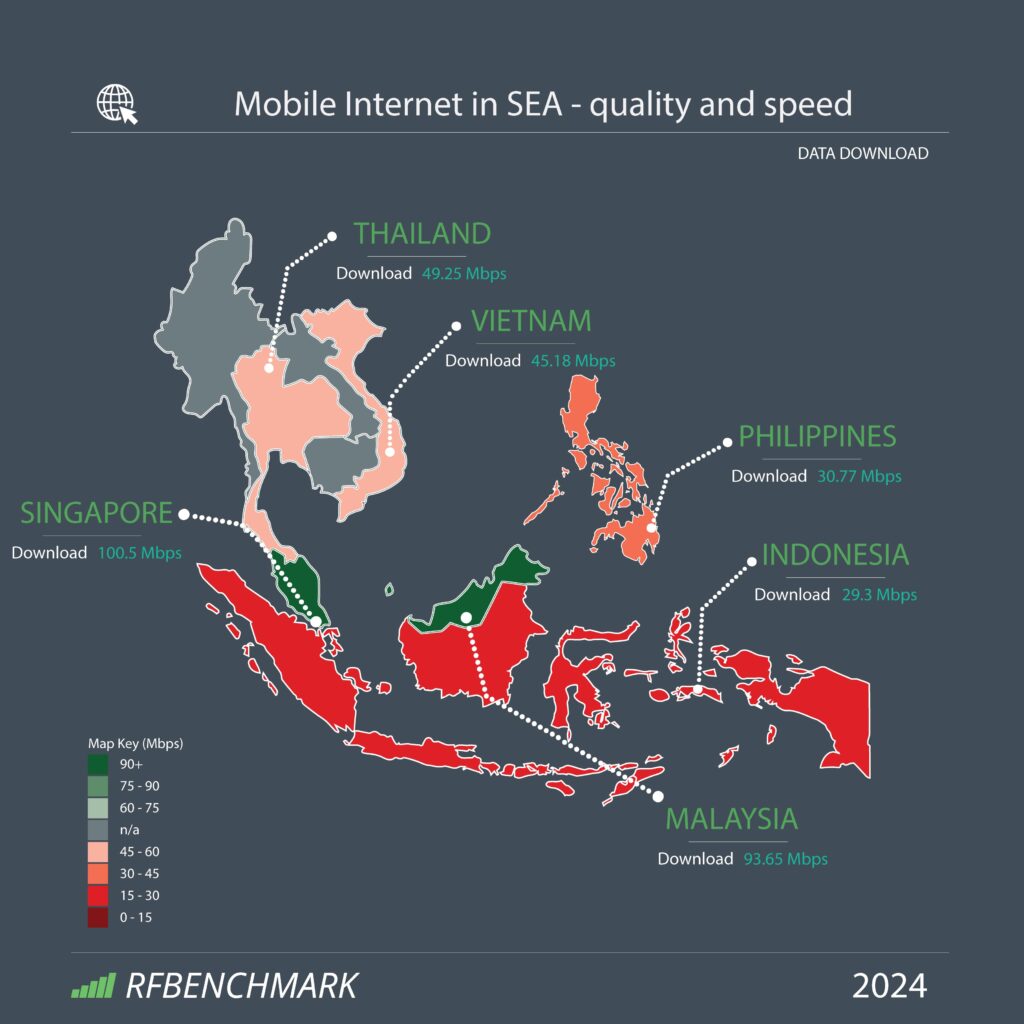
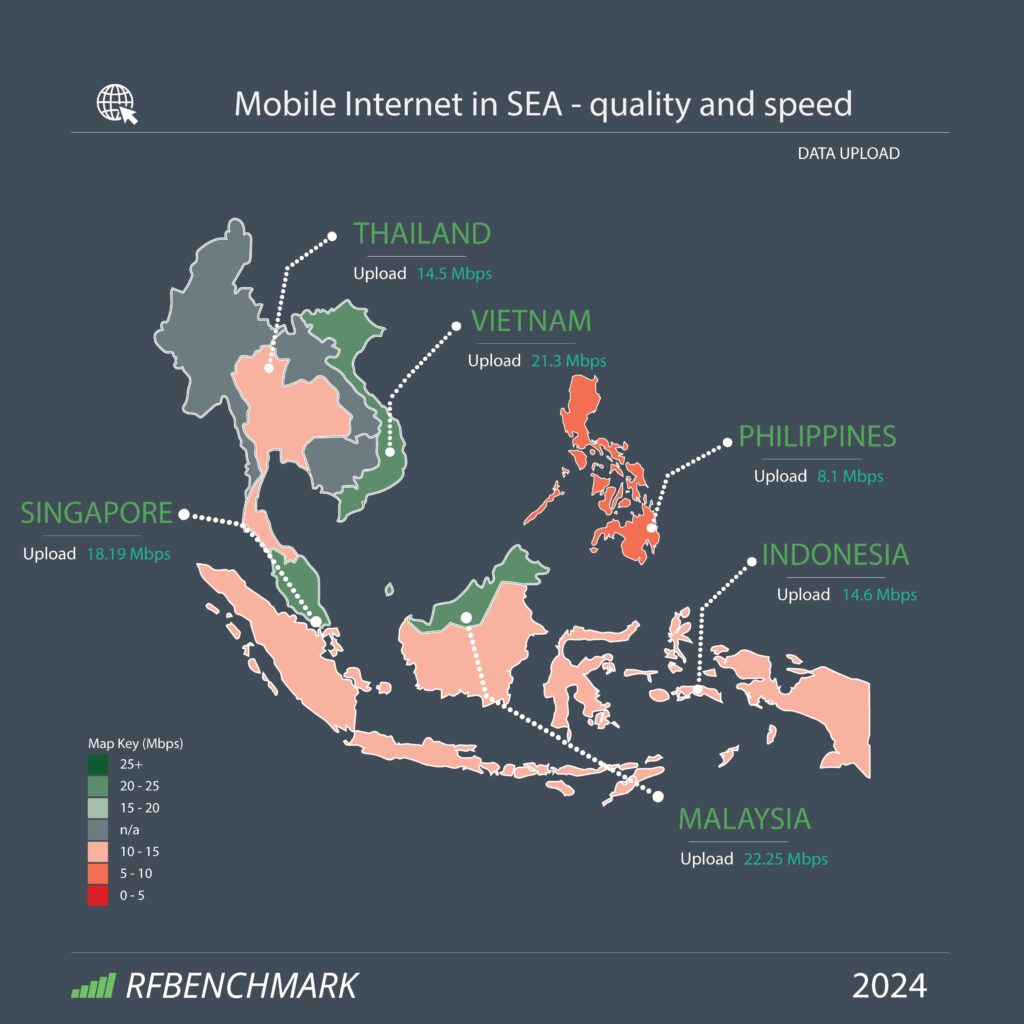
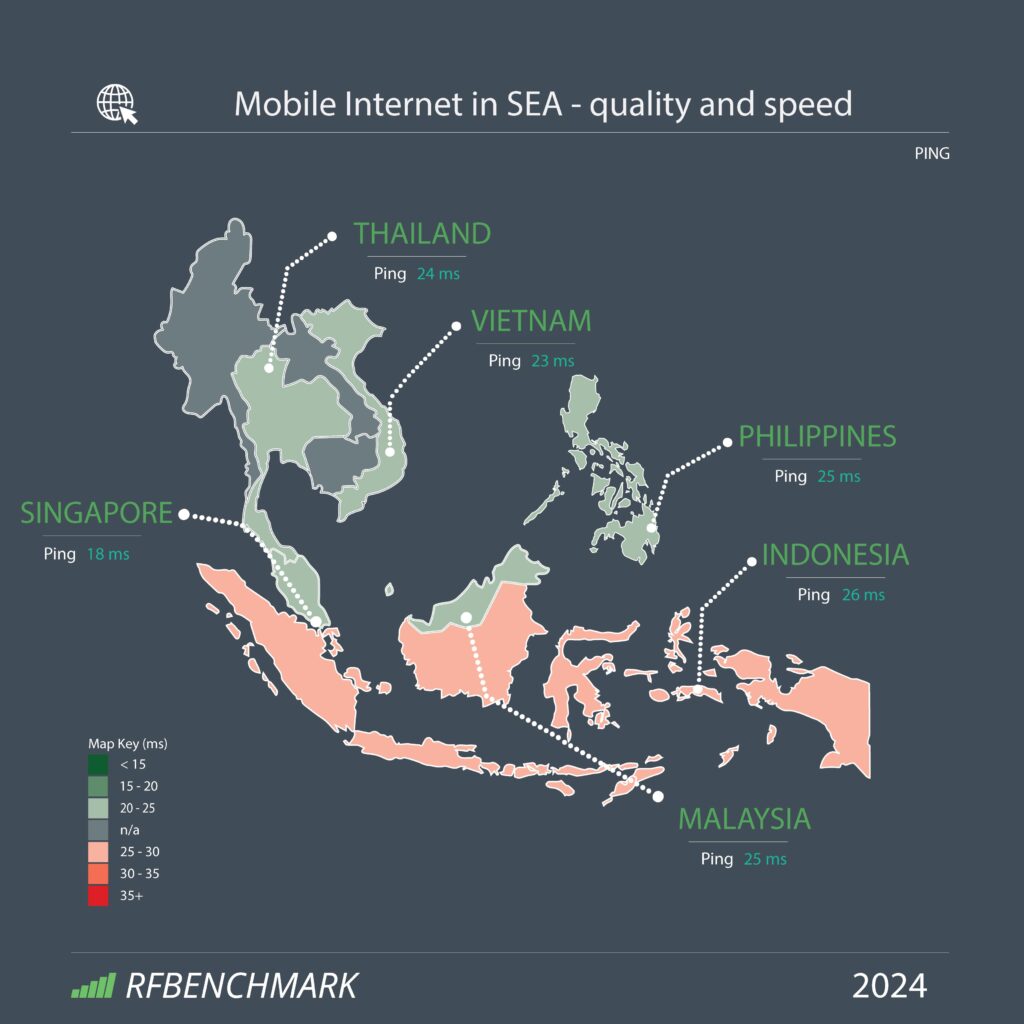


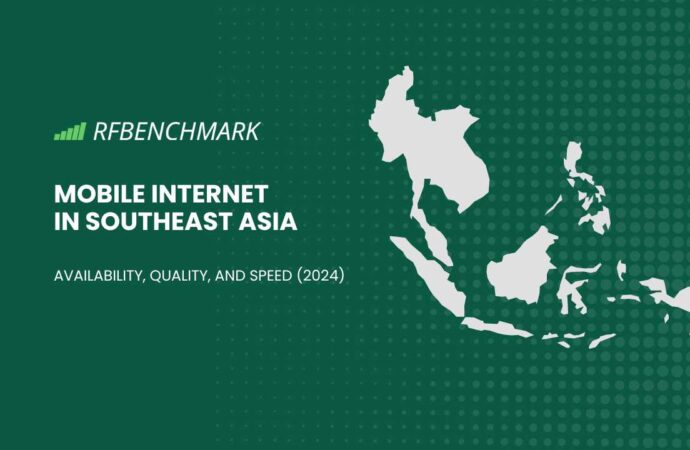







Leave a Comment
Your email address will not be published. Required fields are marked with *